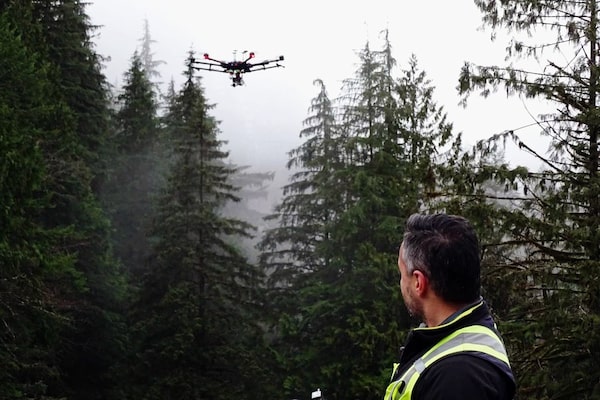
Drones can help First Nations communities map, monitor and manage their forests for sustainable harvest and replanting.Ryan Phipps
Jacob Taylor wants his company to help Indigenous youth recognize that there are exciting opportunities and careers waiting for them in Canada’s forest sector.
The CEO of Indigenous Aerospace – a drone operator, provider and educator – says it’s harder to get Indigenous youth involved in more traditional industries such as forestry because they see it as outdated. Technology, and the drones, can change that.
The company is also showing how technology can support the sustainability goals of both Indigenous communities and the forest sector.
“Not a lot of people want to go and spend significant time in the bush, but with flying robots as a tool in their arsenal, it becomes more exciting, and faster. They’re collecting information in ways that would have normally taken them a couple of days’ trek through the woods in a morning of flying a drone,” says Mr. Taylor, whose company is based in Barrie, Ont., and operates across the country.
“So, it’s really a unique tool.”
Indigenous Aerospace works closely with the forest sector and Indigenous communities to teach them how drones can help map, monitor and manage their forests, for harvesting, planning and protecting.
Mr. Taylor says many First Nations communities are located in forested areas, and he provides relevant technology to help manage forests sustainably for the good of the local economies. “The forest also has other really important meanings to us, as we believe we’re connected to the land, not separate from it,” he explains, adding that healthy forests help medicinal plants and wildlife flourish.
Drones with cameras, combined with sophisticated software, can map an entire forest and create a 2D or 3D image to identify what types of trees are in a stand (or contiguous area), as well as their size and maturity. Data helps operators create a plan for sustainable harvesting and replanting. The drones can also use thermal cameras to determine tree health and see when they’re affected by disease.
“The robot doesn’t miss [anything],” Mr. Taylor says. “It provides accurate geospatial information that is a digital twin of the environment and allows for sophisticated planning, measuring and monitoring. That’s the advantage for companies that deploy the technology.”
Drone technology also allows First Nations communities to monitor activity on their lands and hold forestry companies accountable to ensure they are replanting trees in harvested areas. Further, drones can be used to spot wildfires to help extinguish them before they get too big and threaten communities, Mr. Taylor says.
Innovative companies such as Indigenous Aerospace are just one example of how Indigenous peoples are engaging in the forest sector to support their communities and families.
Forestry is one of the industries in Canada with the most participation by Indigenous peoples. There are about 1,400 Indigenous-owned forestry businesses, and Canada’s forest sector supports jobs in more than 400 Indigenous communities and employs nearly 12,000 Indigenous people, says John Desjarlais, executive director of the Indigenous Resource Network (IRN), a non-partisan research organization that supports and celebrates Indigenous participation in resource development.
“Our work focuses on how Indigenous people [can] live our values but still advance economic development and growth,” he explains. “Because the struggle is that some of the time, those things are contrary [regarding] how you prioritize the land but still develop from it. We have to understand that it’s not a transactional relationship, it’s relational – a relation built on reciprocity.”
IRN also researches how Indigenous communities are participating in the forest sector, either as operators or in partnership with other companies, “and how they’re self-determining and developing resources on their own terms and building a healthier, sustainable economy, which is important for all Canadians,” he says.
Technological advancements in the forestry industry, such as those being used by Indigenous Aerospace, are important for supporting sustainability and efficiency, Mr. Desjarlais says. “Indigenous people are incredibly excited about integrating new processes and technologies that especially align with those views on sustainability.”
For example, IRN is working with Meadow Lake Tribal Council in Saskatchewan, whose nine First Nations members are involved in the forestry industry, from managing forests and mills, to producing lumber, to using waste wood in bioenergy plants. Mr. Desjarlais says they are incredibly proud of the operations and inspired to be using some of the latest technology that helps make the industry more sustainable, while also supporting the local community and economy.
Mr. Taylor says that based on research, more forestry companies are acknowledging that Indigenous communities know how to sustainably manage forests for the long-term benefit of the community.
“We’re just coming to finally understand and acknowledge that,” he explains. “When the tools give the Indigenous people the power to make the decisions and participate in Canadian society and house and feed themselves, it really allows the whole resurgence of our people and that’s really important, especially in our time of truth and reconciliation. And Canadians understand that.”
To learn more about Canada’s forest sector, visit forestryforthefuture.ca.
Advertising feature produced by Globe Content Studio with Forestry For The Future. The Globe’s editorial department was not involved.